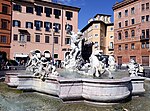Santa Maria dell'Anima

Santa Maria dell'Anima (English: Our Lady of the Soul) is a Roman Catholic church in central Rome, Italy, just west of the Piazza Navona and near the Santa Maria della Pace church. It was founded during the course of the 14th century by Dutch merchants, who at that time belonged to the Holy Roman Empire. In the course of the 15th century, it became the national church of the whole Holy Roman Empire in Rome and henceforth the so-called German national church and hospice of German-speaking people in Rome. In some sources this institution is called Austrian since Habsburg emperors were its protectors.According to tradition, the church received its name, from the picture of Our Lady which forms its coat of arms (the Blessed Virgin between two souls). Among the artworks housed inside is the Holy Family by Giulio Romano. It is the resting place of the Dutch Pope Adrian VI as well as of Cardinals William of Enckenvoirt and Andrew of Austria.
Excerpt from the Wikipedia article Santa Maria dell'Anima (License: CC BY-SA 3.0, Authors, Images).Santa Maria dell'Anima
Via di Santa Maria dell'Anima, Rome Municipio Roma I
Geographical coordinates (GPS) Address External links Nearby Places Show on map
Geographical coordinates (GPS)
| Latitude | Longitude |
|---|---|
| N 41.89975 ° | E 12.472027777778 ° |
Address
Chiesa di Santa Maria dell'Anima
Via di Santa Maria dell'Anima 66
00186 Rome, Municipio Roma I
Lazio, Italy
Open on Google Maps









